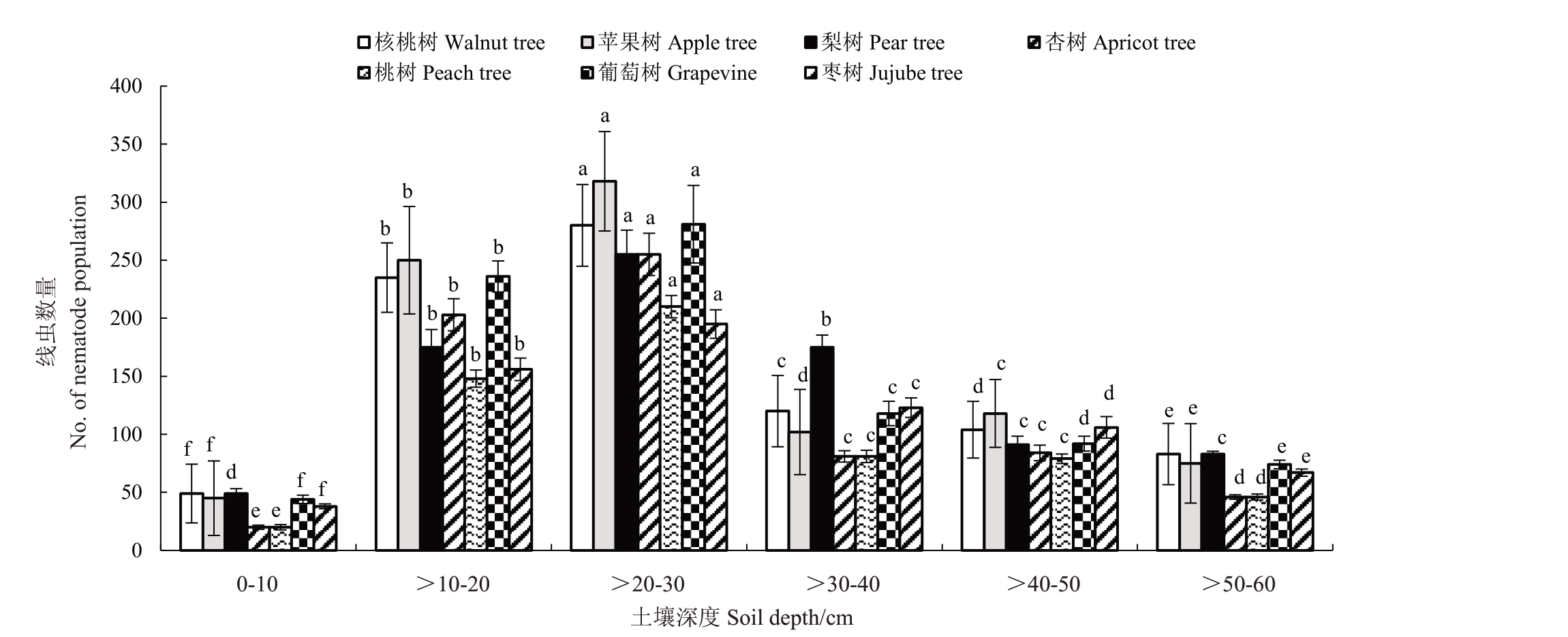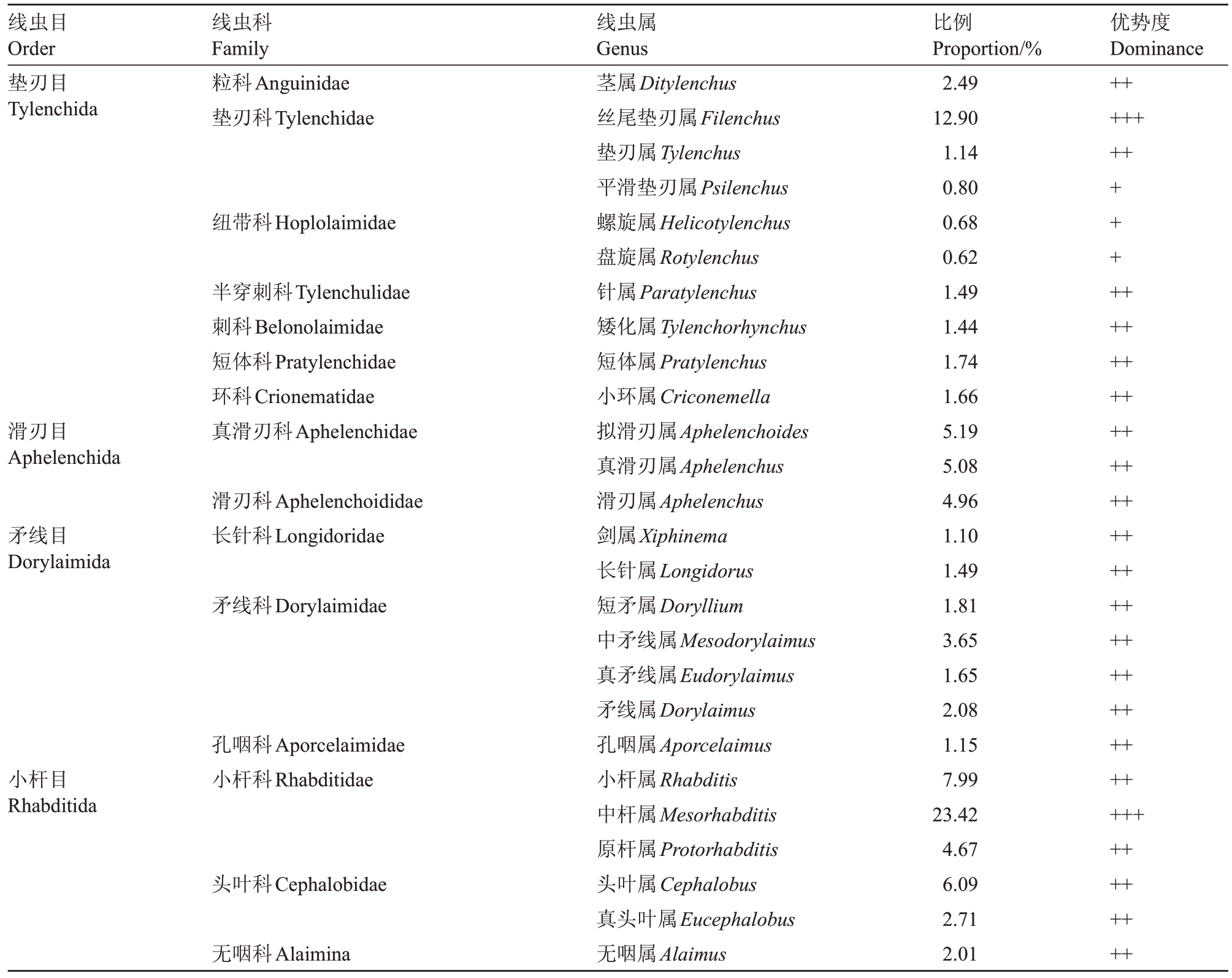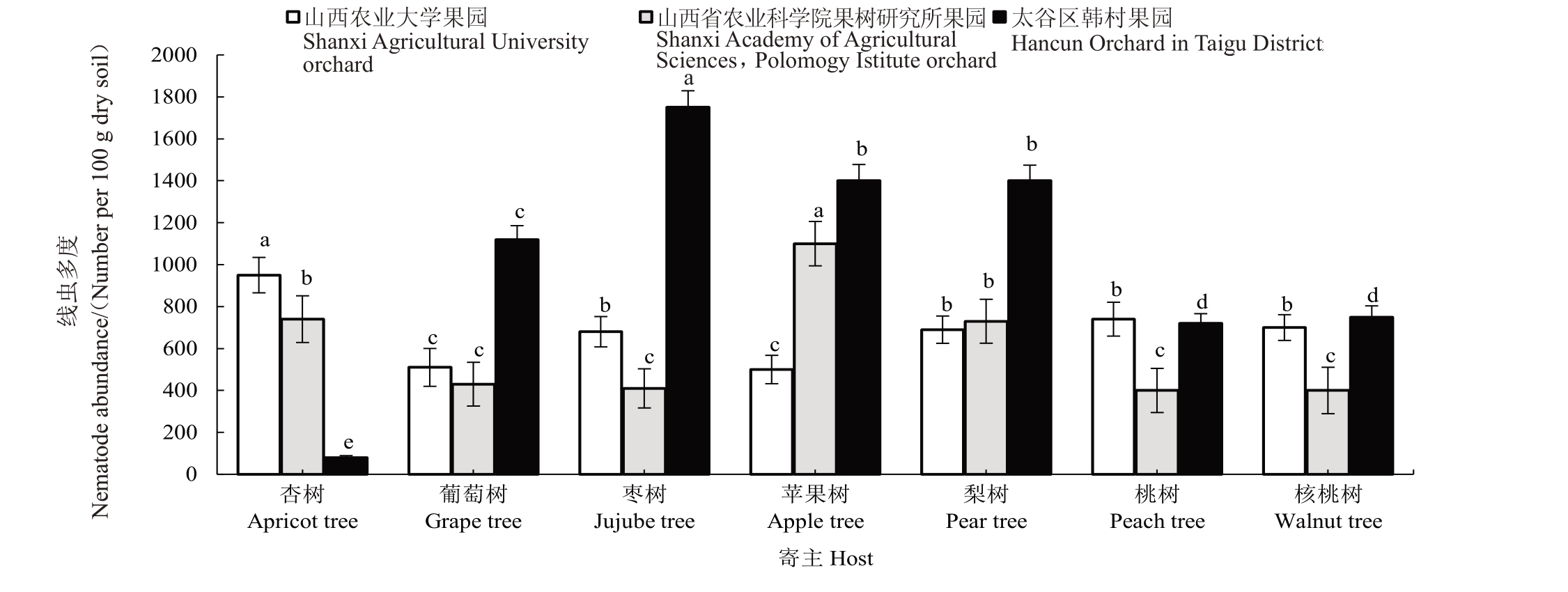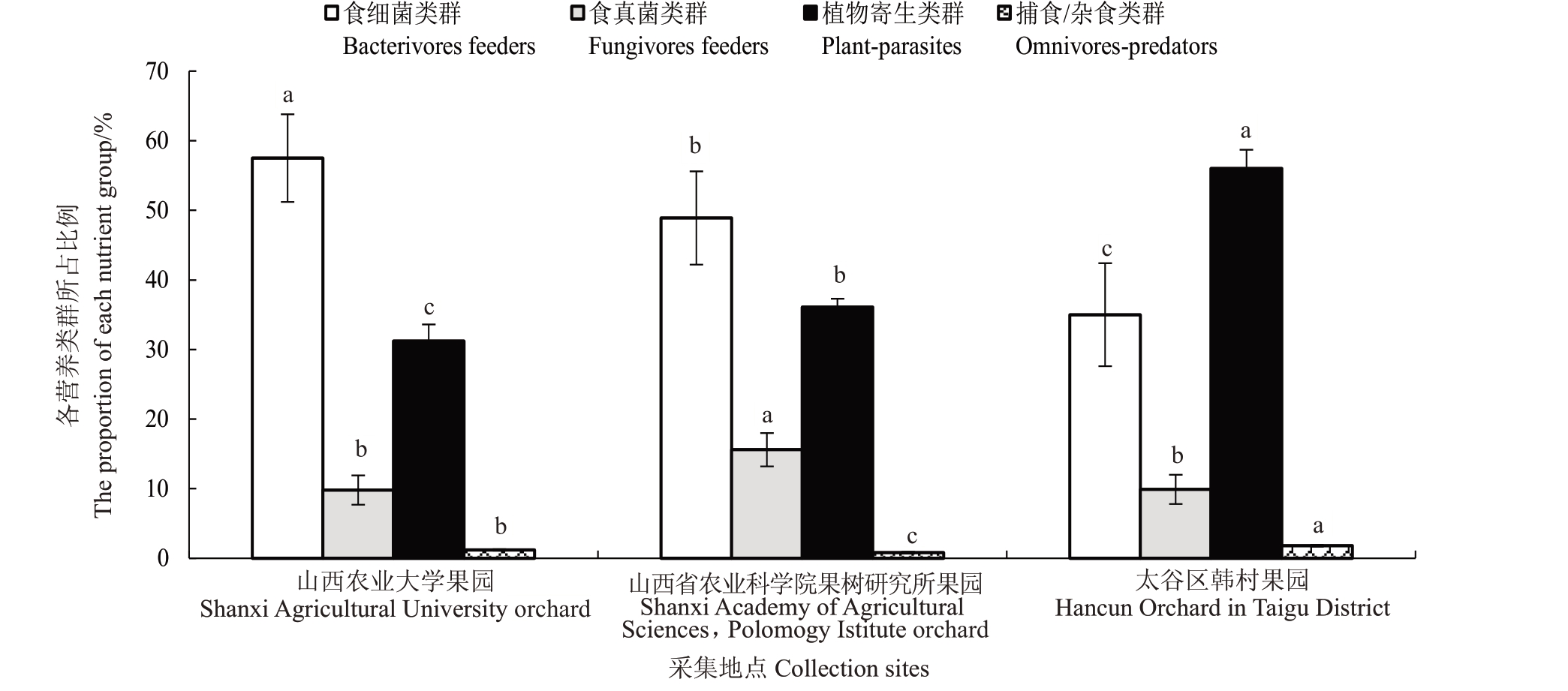线虫是土壤中最丰富的低等无脊椎动物,Van Den Hoogan等[1]估计地球上土壤线虫数量高达4.4×1020头。土壤线虫的60%~80%是自由生活线虫,在土壤食物网的氮矿化和有机质分解中起着重要作用,有些因对食物链和环境反应敏感,可根据土壤线虫种群变化用于指示土壤环境的优劣[2-5]。还有一些植物寄生线虫可引起植物病害,对作物造成经济损失。根据线虫的取食习性,可将土壤线虫分为食细菌类、食真菌类、植物寄生类和捕食/杂食类4 个营养类群[6-7]。不同食性的营养类群,在土壤生态系统中的角色各不相同,尤其是在土壤生态系统稳定性的维持方面作用重大。因此,明确土壤线虫的营养类群及其生物多样性对于土壤健康状况和有害生物监测具有重要的意义。
山西省是我国的水果主产区之一,果树根际土壤线虫种类丰富,但是对其生物多样性研究方面报道较少,因此,笔者在本研究中选取山西省晋中市太谷区常见的杏、梨、苹果、葡萄、枣、桃、核桃等7种果树根际土壤线虫进行群落结构和多样性分析[8-9],旨在明确果树根际土壤线虫的种群数量及其分布情况,为我国土壤动物的生物多样性研究提供丰富的资料,揭示土壤线虫在评估土壤健康水平方面的生物指标作用,为深入探究线虫对果树生产的危害以及控制果树线虫病害提供理论依据。
1 材料和方法
1.1 调查区自然概况
山西省晋中市太谷区(112°28′~113°01′ E,37°12′~37°32′N)位于山西省中部,地处晋中盆地东北部,县域地貌形态分为山地、丘陵、平原,地势由东南向西北倾斜,海拔767~1914 m,属暖温带大陆性气候,四季分明。年平均气温9.8 ℃,无霜期175 d,年平均降水量462.9 mm,地下水资源可开采量9600 m3。春季少雨干燥多风,夏季暖热多雨,秋季天晴气爽,冬季漫长寒冷少雪。太谷区农业基础条件好,果树产业为主要经济产业之一,全区果树种植面积达到8120 hm2,主要种植的果树有苹果、梨、桃、核桃、葡萄、樱桃、杏、山楂、枣等。
1.2 样品采集
选取不同管理水平的3 个果园:管理粗放的山西省农业科学院果树研究所、管理水平中等的山西农业大学太谷校区果园和管理精细的山西省晋中市太谷区韩村果园为试验样地。同一样地对不同树种采用五点取样法,用筒钻取果树根际5~30 cm 深度的土壤样本,将采集的5 个取样点的土壤样品充分混合作为一个土样,3 次重复。每个重复土样按四分法保留500 g土壤样品,装袋封口,并标明采样地、采样时间、寄主植物等,带回实验室处理。共采集土样63个。
选取山西省农业科学院果树研究所果园作为果树根际土壤线虫垂直分布样地,按土壤深度分为6个层次(0~10cm,>10~20cm,>20~30 cm,>30~40 cm,>40~50 cm,>50~60 cm),按五点取样法,不同树种同一层取样土充分混合后按四分法取500 g 作为一个土样,3次重复,共采集土样126个。本试验共采集189个土样,采集的土样迅速带回实验室,放在4 ℃冰箱中保存。
1.3 线虫分离、计数及鉴定
选用浅盘分离法[10]在室温对线虫进行分离。每个土样用电子秤准确称取土样100 g,48 h 后用20 μm 分离筛收集线虫悬浮液,滤去水至筛中剩余悬浮液30~50 mL,转移50 mL 的试管中,静置3 h,去掉上清液,剩下20 mL线虫悬浮液,备用。
摇匀线虫悬浮液,用移液枪取2 mL液体放入表面皿中,在体视显微镜下察看并计算线虫总数。共3 次重复,结果取平均值,计算每100 g 干土壤中存在的线虫数量,最后统计每个分离样品中线虫的数量。
用自制的睫毛挑针挑取线虫,然后放在滴有小水滴的载玻片上,用挑针把浮在水表面的线虫轻轻压入水中,盖上盖玻片。在光学显微镜下观察,并依据《An illustrated key to nematodes found in fresh water》[11]、《植物线虫分类学》[12]和《植物线虫志》[13]将其鉴定到属。
1.4 优势度
将每个样本中线虫个体数量按照其所处属中的比例划分为3个优势度级别。群体中占据超过10%的物种可以称作优势属;占据1%~10%的为常见属;而占据不到1%的则属于稀有属。
1.5 线虫营养类群的划分
通过观察线虫的摄食行为和食道结构,笔者可以将土壤中的线虫群落分为4类不同的营养群[6-7,14]:食细菌类群(bacterivores feeders,BF)、食真菌类群(fungivores feeders,FF)、植物寄生类群(plant-parasites,PP)和捕食-杂食类群(omnivores-predators,OP)。
2 结果与分析
2.1 线虫在果树根际土壤中的垂直分布
不同果树根周围土壤线虫的垂直分布情况见图1,结果显示在0~60 cm深度范围内土壤线虫均有分布,尤其是>20~30 cm深度范围内的土壤线虫数量最为丰富。各土层中核桃树、苹果树和梨树的线虫数量较多,其次是葡萄树,枣树和桃树根围土壤线虫数量较少。

图1 山西省农业科学院果树研究所根际土壤线虫的垂直分布图
Fig.1 The vertical distribution of soil nematodes in orchard of Shanxi Academy of Agricultural Sciences,Polomogy Istitute
不同小写字母表示p<0.05水平显著差异。下同。
Different small letters indicate significant differences at p<0.05.The same below.
2.2 土壤线虫多度与优势度
笔者在本试验中共分离到2纲4目15科26属线虫,如表1 所示,包括15 个属的植物寄生线虫、6 个属的食细菌线虫、3 个属的食真菌线虫以及2 个属的捕食/杂食线虫。在所得到的26 个属中,优势属为丝尾垫刃属和中杆属,占线虫总数的36.32%;常见属为头叶属、拟滑刃属、茎属、真滑刃属、滑刃属、中矛线属、矛线属、小杆属、原杆属、真头叶属、无咽属、垫刃属、小环属、剑属、针属、长针属、短矛属、短体属、真矛线属、孔咽属和矮化属,占线虫总数的61.58%;稀有属为平滑垫刃属、螺旋属和盘旋属,占线虫总数的2.10%。
表1 果树根际线虫鉴定及优势度
Table 1 The identification of rhizosphere nematode in fruit trees and its dominance

注:+++.优势属;++.常见属;+.稀有属。
Notes:+++indicated as the dominant genus;++indicated as the common genus;+indicated that the rare genus.
线虫目Order垫刃目Tylenchida线虫科Family粒科Anguinidae垫刃科Tylenchidae优势度Dominance+++++++纽带科Hoplolaimidae+++++滑刃目Aphelenchida半穿刺科Tylenchulidae刺科Belonolaimidae短体科Pratylenchidae环科Crionematidae真滑刃科Aphelenchidae矛线目Dorylaimida+++++++++++++++++++++++++++++++++++++++滑刃科Aphelenchoididae长针科Longidoridae矛线科Dorylaimidae小杆目Rhabditida孔咽科Aporcelaimidae小杆科Rhabditidae头叶科Cephalobidae无咽科Alaimina线虫属Genus茎属Ditylenchus丝尾垫刃属Filenchus垫刃属Tylenchus平滑垫刃属Psilenchus螺旋属Helicotylenchus盘旋属Rotylenchus针属Paratylenchus矮化属Tylenchorhynchus短体属Pratylenchus小环属Criconemella拟滑刃属Aphelenchoides真滑刃属Aphelenchus滑刃属Aphelenchus剑属Xiphinema长针属Longidorus短矛属Doryllium中矛线属Mesodorylaimus真矛线属Eudorylaimus矛线属Dorylaimus孔咽属Aporcelaimus小杆属Rhabditis中杆属Mesorhabditis原杆属Protorhabditis头叶属Cephalobus真头叶属Eucephalobus无咽属Alaimus比例Proportion/%2.49 12.90 1.14 0.80 0.68 0.62 1.49 1.44 1.74 1.66 5.19 5.08 4.96 1.10 1.49 1.81 3.65 1.65 2.08 1.15 7.99 23.42 4.67 6.09 2.71 2.01
对土壤线虫总数的调查分析(图2)发现,山西农业大学果园果树根际土壤线虫总数范围为500~950条·100 g-1,平均为681条·100 g-1,不同寄主之间线虫多度差异显著,杏树的线虫多度最高,其他寄主的线虫多度均显著低于杏树,其中,以苹果树线虫多度最低;韩村果园果树根际土壤线虫总数范围为80~1750 条·100 g-1,平均为1031 条·100 g-1,不同寄主之间线虫多度差异显著,以枣树的线虫多度为最高,其他寄主的线虫多度均显著低于枣树,其中部分寄主的线虫多度相互间也具有显著差异,以杏树的线虫多度为最低;山西省农业科学院果树研究所果树根际土壤线虫总数范围为400~1100条·100 g-1,平均为601 条·100 g-1,不同寄主之间线虫多度差异显著,以苹果树的线虫多度最高,杏树和梨树次之,其他寄主的线虫多度相互间不具有显著差异。在相同地理环境下不同寄主的土壤线虫多度不同,不同地理环境下相同寄主线虫多度也不同。

图2 山西省7 种果树根际土壤线虫的多度
Fig.2 The abundance of the rhizosphere soil nematodes in orchards of Shanxi province
2.3 土壤线虫营养类群
从土壤线虫的营养类群成分的分析结果(图3)来看,在山西农业大学果园7种果树的根际土壤中,食细菌线虫占比最高,占总体的50%以上,但枣树例外,其占比仅为22.39%,其次,植物寄生性线虫和真菌食性线虫是占据较高比例的种类,而以捕食和杂食为主的线虫占比最少,占总体的2%以下;在韩村果园7种果树的根际土壤中,植物寄生性线虫占比最高,但葡萄和桃树根际土壤中植物寄生性线虫仅占比26.79%和35.14%,食细菌线虫以及真菌食性线虫占比次之,而以捕食和杂食为主的线虫占比最少,占总体的2%以下;在山西省农业科学院果树研究所7种果树的根际土壤中,占比最高的是食细菌线虫,但枣树例外,其占比仅为27.91%,其次,植物寄生性线虫及真菌食性线虫是占据较高比例的种类,而以捕食和杂食为主的线虫占比最少,占总体的1%以下。

图3 山西省果树根际土壤线虫的营养类群分析
Fig.3 The trophic groups in orchard of Shanxi province
3 讨 论
土壤线虫是土壤食物链中重要的组成部分,对植物生长的土壤环境和地上植物具有重要影响。了解果园土壤线虫群落的分布及生物多样性,对深入认识果园土壤环境、提高果园管理水平具有重要意义。
笔者对土壤线虫垂直分布研究发现,线虫多集中于中层土壤,可能的原因是表层土壤属于砂质土,孔隙度小、水分含量不高,且线虫的繁殖数量相对较稀少,尤其是位于土壤表层的0~10 cm深度,线虫数量更是极少。线虫分布受多种因素影响,如水分、植物根分泌物、土壤质地、温度和透气状况等。线虫通常难以在浅层土壤中生存,数量也较少。相比之下,在深20~30 cm 的土壤中更有利于线虫的繁殖和生存。
Viketoft等[15-17]的试验结果表明,植物的特征和功能类型明显地影响着线虫群落的多样性。但是,Viketoft[16]研究了一个半自然草地的线虫群落,只用了8 g湿土进行调查,这个样本量远远少于大多数线虫学家通常使用的200 g湿土来分析线虫群落。因此,这个样本的代表性可能存在问题。尽管各项结果有所不同,但所有这些研究都表明,植物的属性和功能类型会对线虫群落的多样性产生影响。
对线虫土壤营养类群分析发现,食细菌线虫和植物寄生线虫是山西省果树根际的主要营养类群,研究结果与樊金玲[18]报道的山西省果树根际线虫群落结构的结果保持一致。通过比较管理模式发现,管理粗放的山西农业大学和山西省农业科学院果树研究所果园以食细菌线虫为主,而管理精细的韩村果园则以植物寄生线虫为主。食细菌线虫与土壤肥力和植物生产力密切相关,据初步统计,在1 m2森林中就有数十万头食细菌线虫存在,一条食细菌线虫可每天捕食106 个细菌[19],但是果树根际的食细菌线虫与土壤肥力的相关性还有待于进一步研究。其次,植物寄生线虫通过食道腺分泌物和口针穿刺等对植物造成直接危害,每年对全球造成的经济损失高达3582 亿美元[20]。在笔者报道的类群中,短体属(Pratylenchus)可引起植物根腐病害,该属中的非中国种类是我国对外有害生物检疫对象;此外,剑属(Xiphinema)和长针属(Longidorus)可通过传播植物病毒对植物造成间接伤害,这2个属线虫可在葡萄、桃树和梨树上传播葡萄铬色花叶病毒、葡萄扇叶病毒、桃丛簇花叶病毒和梨石果病毒等[21],因此建议在果树上定期监测植物线虫病害及植物病毒病害。
4 结 论
笔者对山西省晋中市太谷区果树根际土壤线虫的种群数量和分布情况进行研究,线虫主要分布于果树根际>20~30 cm 土层中,共鉴定到2 纲4 目15 科26 个属线虫,食细菌线虫是主要的营养类群,植物寄生线虫次之。因此该地区土壤营养类群属于健康,但是应及时监测果园内植物寄生线虫的危害。
[1] VAN DEN HOOGEN J,GEⅠSEN S,ROUTH D,…,CROWTHER T W.Soil nematode abundance and functional group composition at a global scale[J].Nature,2019,572(7768):194-198.
[2] BONGERS T,ALKEMADE R,YEATES G W.Ⅰnterpretation of disturbance-induced maturity decrease in marine nematode assemblages by means of the Maturity Ⅰndex[J].Marine Ecology Progress Series,1991,76:135-142.
[3] ETTEMA C H,BONGERS T.Characterization of nematode colonization and succession in disturbed soil using the Maturity Ⅰndex[J].Biology and Fertility of Soils,1993,16(2):79-85.
[4] FRECKMAN D W,ETTEMA C H.Assessing nematode communities in agroecosystems of varying human intervention[J].Agriculture,Ecosystems & Environment,1993,45(3/4):239-261.
[5] YEATES G W.How plants affect nematodes[J].Advances in Ecological Research,1987,17:61-113.
[6] YEATES G W,WARDLE D A,WATSON R N.Relationships between nematodes,soil microbial biomass and weed-management strategies in maize and asparagus cropping systems[J].Soil Biology and Biochemistry,1993,25(7):869-876.
[7] BONGERS T,BONGERS M.Functional diversity of nematodes[J].Applied Soil Ecology,1998,10(3):239-251.
[8] 王寿华.果树线虫学[M].北京:中国农业科技出版社,1994:22-24.WANG Shouhua.Fruit nematology[M].Beijing:China Agricultural Science and Technology Press,1994:22-24.
[9] 丁兆龙,高士仁,张河生,时呈奎,岳凤荣,丁爱云,耿忠义,李宁.桃、梨树根际线虫研究[J].山东农业大学学报,1995,26(1):35-40.DⅠNG Zhaolong,GAO Shiren,ZHANG Hesheng,SHⅠChengkui,YUE Fengrong,DⅠNG Aiyun,GENG Zhongyi,LⅠNing.Studies on nematodes in peach and pear treerhizosphere[J].Journal of Shandong Agricultural University,1995,26(1):35-40.
[10] WHⅠTEHEAD A G,HEMMⅠNG J R.A comparison of some quantitative methods of extracting small vermiform nematodes from soil[J].Annals of Applied Biology,1965,55(1):25-38.
[11] TARJAN A C,ESSER R P,CHANG S L.An illustrated key to nematodes found in fresh water[J].Journal of Water Pollution Control Federation,1977,49(11):2318-2337.
[12] 谢辉.植物线虫分类学[M].2 版.北京:高等教育出版社,2005:17-36.XⅠE Hui.Taxonomy of plant nematodes[M].2nd ed.Beijing:Higher Education Press,2005:17-36.
[13] 刘维志.植物线虫志[M].北京:中国农业出版社,2004.LⅠU Weizhi.Description of the species of plant parasitic nematodes[M].Beijing:China Agriculture Press,2004.
[14] 梁文举,姜勇,李琪,陈利军,曲业兵.施用化肥对下辽河平原稻田土壤线虫群落产生的影响[J].土壤通报,2004,35(6):773-775.LⅠANG Wenju,JⅠANG Yong,LⅠQi,CHEN Lijun,QU Yebing.Effect of chemical fertilizers on paddy soil nematode communities in the lower reaches of Liaohe plain[J].Chinese Journal of Soil Science,2004,35(6):773-775.
[15] VⅠKETOFT M,PALMBORG C,SOHLENⅠUS B,HUSSDANELL K,BENGTSSON J.Plant species effects on soil nematode communities in experimental grasslands[J].Applied Soil Ecology,2005,30(2):90-103.
[16] VⅠKETOFT M.Plant induced spatial distribution of nematodes in a semi-natural grassland[J].Nematology,2007,9(1):131-142.
[17] VⅠKETOFT M.Effects of six grassland plant species on soil nematodes:A glasshouse experiment[J].Soil Biology and Biochemistry,2008,40(4):906-915.
[18] 樊金玲.山西省果树根际植物线虫的种类及群落结构研究[D].太谷:山西农业大学,2019.FAN Jinling.Plant parasitic nematode species and community structure under the rhizosphere of fruit trees in Shanxi province[D].Taigu:Shanxi Agricultural University,2019.
[19] ⅠNGHAM R E,TROFYMOW J A,ⅠNGHAM E R,COLEMAN D C.Ⅰnteractions of bacteria,fungi,and their nematode grazers:Effects on nutrient cycling and plant growth[J].Ecological Monographs,1985,55(1):119-140.
[20] ABD-ELGAWAD M M M,ASKARY T H.Ⅰmpact of phytonematodes on agriculture economy[M]//ASKARY T H,MARTⅠ-NELLⅠP R P.Biocontrol agents of phytonematodes.Wallingford:CABⅠ,2015:3-49.
[21] XU Y M,ZHAO Z Q.Longidoridae and Trichodoridae(Nematoda:Dorylaimida and Triplonchida)[M].Lincoln,New Zealand:Landcare Research,2019.